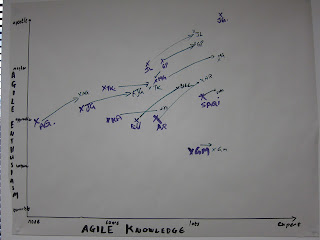Caveats:
None for using, but please be sensible whenever thinking and applying a model of thought. It's all abstract and in that experiential space - nothing is perfect for everyone in every context.
Required:
This is a "chat through" session with a coachee or a group
30 minutes and more, dependent on the group's size and engagement
Read the wikipedia page http://en.wikipedia.org/wiki/Flow_(psychology) and be sure to click on all the segments in the picture which are links to a bit more detail which you will need to know and understand.
Step 3: And as the picture is quite self-explanatory, especially having read the background reading available on wikipedia and other sources, the conversation is quite easy to have. I ask for examples of what tasks the coachee or the group members perform that are Low in Challenge Level, and Low in Skill Level.
3.The clearer and more immediate feedback the person receives whilst engaged, helps the person get into this "super state" and then stay there for longer
Flow psychology provides a great tool for explaining the enjoyment people report when they embrace modern/agile software engineering practices like Test Driven Development, Pairing, Collaborative Design and more.
I have not read Mihaly Csikszentmihalyi's book Flow: The Psychology of Optimal Experience yet, but I find the graph he drew above incredibly useful when talking to people about their experiences of work - what they have really loved in the past, and helping them understand what they are experiencing currently. This tool helps provide some motivational energy to help people make a decision to try something new.
yet, but I find the graph he drew above incredibly useful when talking to people about their experiences of work - what they have really loved in the past, and helping them understand what they are experiencing currently. This tool helps provide some motivational energy to help people make a decision to try something new.
None for using, but please be sensible whenever thinking and applying a model of thought. It's all abstract and in that experiential space - nothing is perfect for everyone in every context.
Required:
This is a "chat through" session with a coachee or a group
30 minutes and more, dependent on the group's size and engagement
Read the wikipedia page http://en.wikipedia.org/wiki/Flow_(psychology) and be sure to click on all the segments in the picture which are links to a bit more detail which you will need to know and understand.
Step 1: I either draw something similar or show the coachee or the group the following image (available in the public domain from http://en.wikipedia.org/wiki/File:Challenge_vs_skill.svg)
Step 2: Most important - do not cast, nor allow any group member to cast, any verbal or non-verbal judgements! This is self-perception stuff, so with a group, as facilitator of constructive listening and volunteering of important "self" information, the session must be managed sensitively and sensibly.
Step 3: And as the picture is quite self-explanatory, especially having read the background reading available on wikipedia and other sources, the conversation is quite easy to have. I ask for examples of what tasks the coachee or the group members perform that are Low in Challenge Level, and Low in Skill Level.
I then ask for examples on each flanking side, 1 sector at a time (ie, Medium Challenge Level with Low Skill Level, Medium Skill Level with Low Challenge Level) until finally reaching Flow.
Typically the sectors before Flow are quite quick and easy to find good examples for, though it is always interesting for me to see how house/admin chores such as sweeping, filing, dusting move around between Apathy-Boredom-Relaxation. And the same for what kind of tasks such as public speaking, waiting for feedback from a client proposal, writing a proposal, move between Apathy, Worry and Anxiety.
Often teaching, managing and mentoring type activities appear in the Control sector.
And sporting, extreme sporting, and "breaking the ice" with someone that is liked appears in Arousal sector.
And then, the tough one is discovered, and the real soul and past experience searching begins: Flow.
Step 4: Helping identify tasks that represent true Flow state requires covering the information found on wikipedia, summarised here:
1.The person must be engaged with something that has clear goals in order to provide direction and structure (aka Vision)
2.The person must believe that they have a good balance between the perceived challenges of the task and their own perceived skills - they must be confident.3.The clearer and more immediate feedback the person receives whilst engaged, helps the person get into this "super state" and then stay there for longer
Flow psychology provides a great tool for explaining the enjoyment people report when they embrace modern/agile software engineering practices like Test Driven Development, Pairing, Collaborative Design and more.
I have not read Mihaly Csikszentmihalyi's book Flow: The Psychology of Optimal Experience
And for team building, this tool provides great insights into the kinds of work individuals really want to do, to feel alive, to contribute as much as possible whilst at work, to be themselves, and to be with others, contributing to team success based on capability and capacity rather than role.
I like bringing this tool into discussion with the results from Belbin (see Coaching with Belbin), the Free Strength Finder (see Coaching with Free Strengths Finder), the preferred learning styles VAK (see Coaching with Free VAK (Learning Styles Visual Auditory Kinaesthetic)), and the positivity ratio (see Coaching With Free Positivity Ratio Tool). Together they provide a couple of very useful views on people that allow for the creation of great coaching plans, team plans, and ultimately greatly enhanced self-awareness.
Thankyou for supporting! Let me know what you think!
Thankyou for supporting! Let me know what you think!





